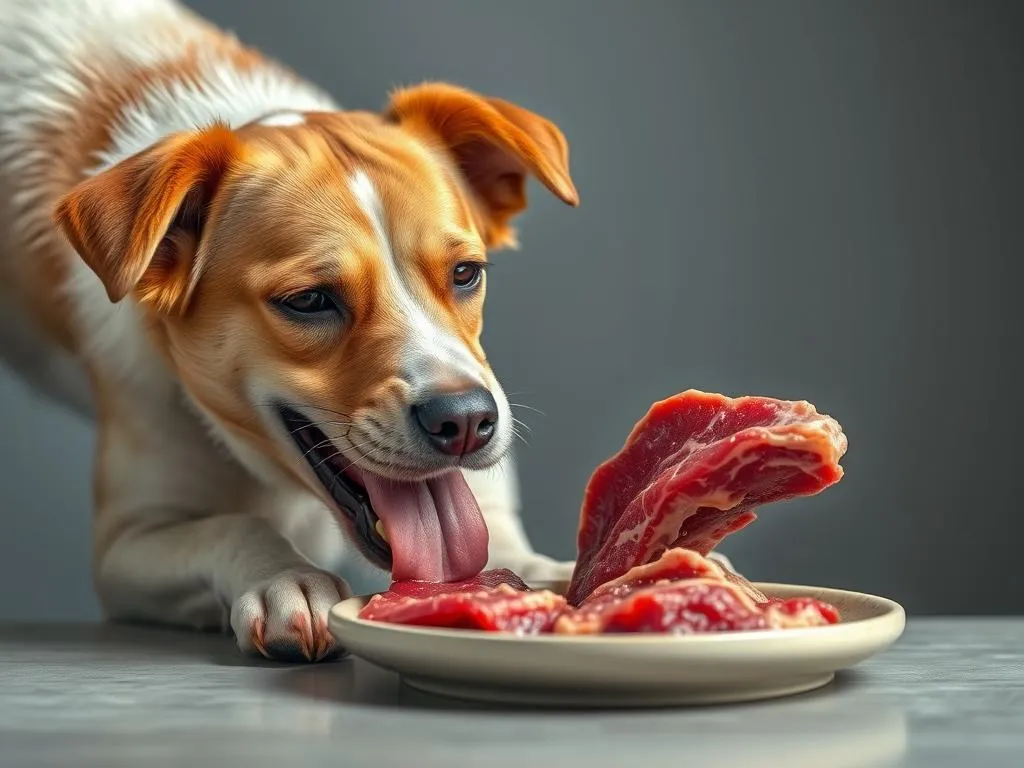
Introduction
Overview of Dog Nutrition
Understanding dog nutrition is crucial for ensuring the long-term health and happiness of our furry friends. Proper nutrition plays a vital role in a dog’s growth, energy levels, and overall well-being. The market offers various dog food options, ranging from commercial kibble to high-end gourmet meals. However, as pet owners seek the best for their pets, the conversation around raw feeding has gained significant traction.
Focus of the Article
This article will delve into the specific question: Can dogs eat raw meat? It’s essential to explore the pros and cons of incorporating raw meat into a dog’s diet, as well as the nutritional requirements that influence such choices.
Understanding Canine Dietary Needs
Nutritional Requirements for Dogs
Dogs, like humans, require a balanced diet to thrive. Essential nutrients include:
- Proteins: For muscle development and immune function.
- Fats: For energy and healthy skin and coat.
- Carbohydrates: For energy and digestive health.
- Vitamins and Minerals: For various bodily functions.
The dietary needs of dogs can vary significantly based on factors such as breed, age, and specific health conditions. For instance, puppies require more protein for growth, while older dogs may need fewer calories to maintain a healthy weight.
The Role of Protein in a Dog’s Diet
Protein serves as a crucial building block for a dog’s body. It aids in muscle growth, tissue repair, and overall health. In commercial dog food, protein sources can vary widely, with some brands using meat by-products and fillers. Conversely, raw meat can provide high-quality protein without unnecessary additives. Understanding the source of protein is essential for any pet owner considering their dog’s diet.
The Raw Diet Movement
What is a Raw Dog Food Diet?
A raw dog food diet typically consists of uncooked meat, bones, organs, and sometimes fruits and vegetables. This approach aims to mimic what dogs’ ancestors would have eaten in the wild, focusing on natural ingredients devoid of processing.
History and Popularity of Raw Feeding
The concept of raw feeding has evolved over the years, gaining popularity among pet owners who seek a more natural approach to feeding their dogs. Many choose raw diets for perceived health benefits, including improved coat condition, increased energy levels, and better digestion. However, understanding the underlying principles of this diet is essential for making an informed decision.
Can Dogs Eat Raw Meat?
Nutritional Benefits of Raw Meat
One of the main arguments in favor of feeding dogs raw meat is the high-quality protein it provides. Raw meat is rich in:
- Essential Fatty Acids: Important for skin and coat health.
- Natural Enzymes: Some proponents argue that raw meat contains enzymes that can aid digestion and are often destroyed during cooking.
- Vitamins and Minerals: Raw meat often retains more nutrients compared to cooked options, which can lose valuable vitamins during the cooking process.
Potential Risks of Feeding Raw Meat
Despite its benefits, there are potential risks associated with feeding dogs raw meat:
- Bacterial Contamination: Raw meat can harbor harmful bacteria such as Salmonella and E. coli, which pose a risk to both dogs and their owners.
- Nutritional Imbalances: A diet solely consisting of raw meat may lead to deficiencies in essential nutrients if not balanced with other food components.
- Risk of Injury: Bones can splinter and cause choking or internal injuries if not handled or selected carefully.
These risks highlight the importance of thorough research and consultation with a veterinarian before transitioning to a raw meat diet.
Expert Opinions and Research
Veterinary Perspectives
Veterinarians often have varied opinions on raw feeding. Some may advocate for it under specific circumstances, such as when a dog has allergies or sensitivities to commercial food. Others may caution against it, especially in cases of compromised immune systems or specific health conditions. It’s essential to listen to professional guidance when considering dietary changes.
Scientific Studies on Raw Feeding
Recent research has explored the effects of raw feeding versus traditional commercial diets. Some studies indicate that while raw diets can provide certain benefits, they may also lead to health risks if not carefully managed. For instance, a comprehensive study might compare the nutrient profiles of raw diets and commercial kibble, providing insights into their respective advantages and disadvantages.
How to Safely Implement a Raw Meat Diet
Choosing the Right Raw Meat
Selecting high-quality meat is crucial when considering a raw diet. Suitable meats for dogs include:
- Beef
- Chicken
- Lamb
- Turkey
Sourcing human-grade meat from reputable suppliers can help ensure that the meat is safe and free from harmful additives.
Safe Handling and Preparation
To minimize risks associated with feeding raw meat, proper handling is essential:
- Always wash hands and surfaces after handling raw meat.
- Store raw meat at the correct temperatures to prevent bacterial growth.
- Avoid cross-contamination with other foods.
Additionally, pet owners may consider supplements to ensure their dog’s diet is balanced, including:
- Vitamins
- Minerals
- Essential fatty acids
Transitioning to a Raw Diet
When introducing raw meat to a dog’s diet, gradual transition is key. Start by mixing small amounts of raw meat with their current food, slowly increasing the proportion over several days. Observing your dog’s health and digestion during the transition period is crucial to ensure they adapt well.
Alternatives to Raw Meat
Commercial Raw Diet Options
For those interested in raw feeding but concerned about preparation and safety, commercial raw dog food products are available. These options are often formulated to meet nutritional guidelines and are pre-packaged for convenience. They can offer a balanced diet while minimizing handling risks.
Balanced Cooked Diets
Cooking meat for dogs is another viable alternative. A balanced cooked diet can provide many of the same benefits as a raw diet while eliminating the risks associated with raw meat. Pet owners can prepare meals at home, ensuring they include a mix of protein, vegetables, and grains for a complete nutritional profile.
Conclusion
In summary, the question of whether dogs can eat raw meat is multifaceted, encompassing nutritional benefits and potential risks. While raw meat can provide high-quality protein and essential nutrients, it also poses risks of bacterial contamination and nutritional imbalances. Consulting with a veterinarian is vital before making any significant dietary changes for your dog.
Ultimately, pet owners should consider their dog’s individual needs and preferences when it comes to nutrition. Continuous education about dog nutrition will empower owners to make informed decisions that foster the health and happiness of their beloved pets.









